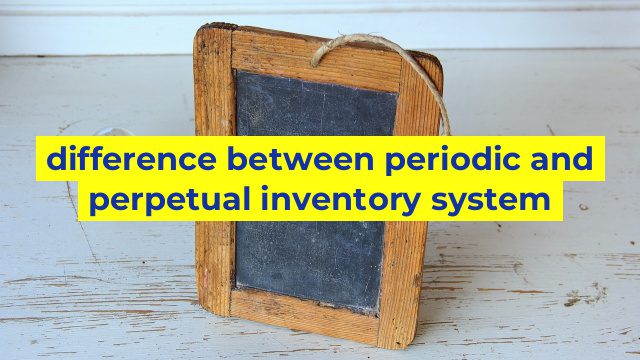Difference Between Periodic and Perpetual Inventory System
Inventory management is a crucial aspect of any business. It is essential to monitor the inventory levels to ensure that the products are available when needed. The two primary methods used to track inventory are the periodic inventory system and the perpetual inventory system. Both systems have their advantages and disadvantages. In this article, we will explore the differences between the two inventory systems.
The Periodic Inventory System
The periodic inventory system is a traditional method of inventory management. In this system, the inventory levels are tracked at the end of a specific period, usually monthly or quarterly. During this period, the company does not continuously monitor the inventory levels. Instead, the inventory levels are counted and recorded in the books of account.
The periodic inventory system is suitable for small businesses with a limited inventory level. It is also beneficial for businesses dealing with slow-moving products or products with a long shelf life. The system is simple, and businesses do not require sophisticated software to use it.
However, the periodic inventory system has several disadvantages. First, the company cannot track the inventory levels in real-time. This makes it difficult to identify inventory discrepancies that may arise due to theft or damage. Second, the inventory count can be time-consuming and costly. The business may have to hire extra staff to count the inventory levels manually.
The Perpetual Inventory System
The perpetual inventory system is a modern method of inventory management. In this system, the inventory levels are continuously monitored in real-time. The company uses software that tracks the inventory levels whenever a product is sold or purchased.
The perpetual inventory system is suitable for businesses with high inventory levels, fast-moving products, or products with a short shelf life. The system is efficient, and businesses can identify inventory discrepancies as soon as they occur.
However, the perpetual inventory system requires sophisticated software and hardware to operate. The system can be expensive to install and maintain. Small businesses may not afford the perpetual inventory system.
Conclusion
In conclusion, both the periodic inventory system and the perpetual inventory system have their advantages and disadvantages. The choice between the two inventory systems depends on the business’s size, the inventory level, and the nature of the products. Small businesses with limited inventory levels can use the periodic inventory system, while larger businesses can use the perpetual inventory system. Ultimately, the goal of the inventory management system should be to ensure that the products are available when customers need them.
Table difference between periodic and perpetual inventory system
| Periodic Inventory System | Perpetual Inventory System | |
|---|---|---|
| Definition | A system of inventory management where inventory levels are updated periodically (usually around the end of each accounting period). | A system of inventory management where inventory levels are updated continuously, in real-time. |
| Inventory Count | Inventory counts are done periodically (often annually or semi-annually). | Inventory counts are done regularly (often daily, weekly, or monthly). |
| Inventory Valuation | Inventory is valued based on a physical count at the end of the accounting period. | Inventory is valued based on a running balance in real-time. |
| Cost of Goods Sold | The cost of goods sold is calculated at the end of the accounting period based on the inventory count. | The cost of goods sold is calculated in real-time based on the running balance. |
| Inventory Tracking | Inventory tracking is done manually or with simple software. | Inventory tracking is done with sophisticated inventory management software. |
| Level of Accuracy | The level of accuracy is lower compared to perpetual inventory system. | The level of accuracy is higher compared to periodic inventory system. |
| Risks | There is a greater risk of stockouts and overstocking. | The risk of stockouts and overstocking is minimized due to real-time inventory tracking. |

